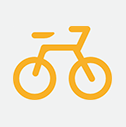The Driver's Handbook
Motorcycles

Motorcycles are classified as motor vehicles and are therefore subject to the same general road rules as cars, trucks and other motor vehicles. Specific road laws apply to motorcycle riders. These are:
- an approved helmet must always be worn
- motorcycles built after June 1975 must have two rear view mirrors to provide a clear view of the road behind
- only one pillion passenger may be carried and then only if the bike is fitted with proper footrests and seating
- pillion passengers must always sit astride the seat facing forwards and with both feet on the footrests
- learner riders must not carry a passenger either as a pillion or in a side car. This includes a person acting as a Qualified Supervising Driver
- Learner riders must not tow a trailer
- overtaking on the left of another vehicle in the same lane is illegal unless the other vehicle is turning right
- riders may ride two-abreast but no more than 1.5 metres apart
- both the rider and passenger are responsible for ensuring the passenger wears an approved helmet and appropriate protective clothing
- a child under the age of eight years cannot be carried as a pillion passenger on a motorcycle. They may only be carried in a sidecar
- all sidecar passengers must be safely seated at all times that the motorcycle is moving
- an animal cannot be carried on the petrol tank of a motorcycle (except a farm animal carried for less than 500 metres).
Recommended equipment
Clothing of strong, brightly coloured material covering arms and legs is recommended.
Leather gloves offer good protection for hands and enclosed, sturdy footwear protects feet.
You should never ride in sandals, thongs or bare feet.
Lane Filtering
Lane filtering is when a motor bike rider travels at low speed in between two lines of stationary or slow moving traffic travelling in the same direction.
Strict conditions apply to lane filtering:
- only permitted when safe to do so
- only permitted at speeds of 30km/h or slower
- only permitted by R and R-Date licensed motor bike riders. Learner’s Permit holders, P1 Provisional licence holders and moped riders with a car licence only must not lane filter
- not permitted in a school zone or across pedestrian and children’s crossings
- not permitted next to parked cars or between vehicles and the kerb, or on roundabouts
- not permitted in bicycle, bus or tram lanes.
Being seen
The outline of a motorcycle is about one-third the size of a car, which makes it difficult for drivers to see them especially among other vehicles.
Remember that a motorcycle rider can see a car much better than a driver can see a motorcycle.
To improve your chances of being seen by other road users, it is recommended that you:
- wear bright coloured clothing
- ride with your headlight on at all times
- ride in a position on the road that provides maximum safety and visibility of your motorcycle to other road users (especially not in the blind spots of other vehicles).
Equipment and clothing

When choosing equipment and clothing, bear in mind the purpose: VISIBILITY as well as PROTECTION.
Compulsory equipment
A motorcycle rider, any pillion passenger and any passenger in a side car must wear an approved safety helmet. An ‘approved’ helmet is a helmet manufactured, tested and marked in accordance with the requirements of the Australian Standard (AS 1698) or European Standard (ECE 22.05) as specified in the Road Traffic (Miscellaneous) Regulations 2014.
Further information about motorcyclist safety can be found in the Rider’s Safety Handbook.
A white or brightly coloured helmet provides good visibility both by day and night. The helmet must be fit for purpose and in good condition and be a firm fit.































